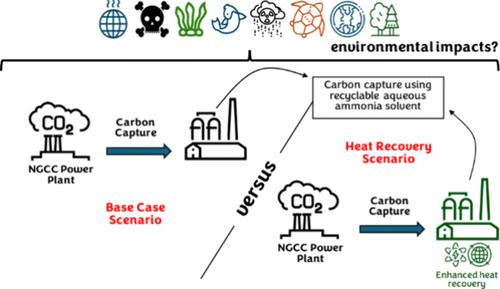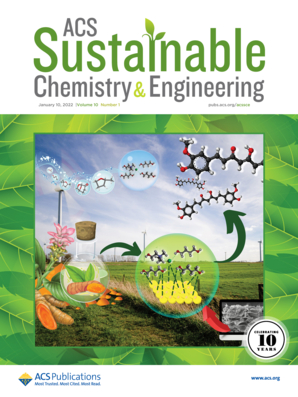Comparative Industrial-Scale Life Cycle Assessment of Base Case and Heat Recovery Scenarios for Carbon Capture from Natural Gas Combined Cycle Power Plants Using Aqueous Ammonia
IF 7.3
1区 化学
Q1 CHEMISTRY, MULTIDISCIPLINARY
引用次数: 0
Abstract
As social and economic activities return to pre-COVID-19 levels, greenhouse gas emissions continue to rise, exacerbating climate change. This study explores carbon capture and sequestration (CCS) technologies to mitigate carbon dioxide (CO2) emissions from natural gas combined cycle (NGCC) power plants, proposing aqueous ammonia as a solvent due to its high reactivity and lower energy regeneration requirements. A life cycle assessment (LCA) was conducted to compare a base case with a heat recovery scenario for capturing 300 kilotonnes of CO2 annually from NGCC flue gas. The cradle-to-gate LCA, using a functional unit of 1 tonne of CO2 input, encompasses the process from flue gas extraction to the production of purified CO2. The heat recovery scenario outperformed the base case in all environmental impact categories. The LCA results indicated a net carbon abatement of 94.49 kg CO2 eq for the base case and 508.69 kg CO2 eq for the heat recovery scenario. Key contributors to global warming potential (GWP) included electricity consumption and heat production, while the human toxicity potential (HTP) and marine aquatic ecotoxicity potential (MAETP) were significant environmental impact categories. Sensitivity analysis and Monte Carlo simulation highlighted critical parameters and uncertainties, and scenario analysis examined additional variables for a comprehensive assessment. Aqueous ammonia not only lowers emissions but also provides cost-effectiveness and high absorption efficiency, positioning it as a viable option for large-scale CO2 capture. Additionally, it has potential for future integration with the carbonation of municipal and industrial solid waste, contributing to sustainable waste management and carbon sequestration.

基于水氨的天然气联合循环发电厂碳捕获的基本情况和热回收情景的工业规模生命周期比较评估
随着社会和经济活动恢复到疫情前的水平,温室气体排放继续上升,加剧了气候变化。本研究探讨了碳捕获和封存(CCS)技术,以减少天然气联合循环(NGCC)发电厂的二氧化碳(CO2)排放,并提出了水氨作为溶剂,因为它具有高反应性和较低的能量再生要求。进行了生命周期评估(LCA),将基础情景与每年从NGCC烟气中捕集30万吨二氧化碳的热回收情景进行比较。从摇篮到闸门的LCA使用1吨二氧化碳输入的功能单元,包括从烟气提取到生产纯化二氧化碳的过程。热回收方案在所有环境影响类别中都优于基本情况。LCA结果表明,基本情景的净碳减排量为94.49 kg CO2当量,热回收情景的净碳减排量为508.69 kg CO2当量。全球变暖潜势(GWP)的主要影响因素包括电力消耗和热力生产,而人类毒性潜势(HTP)和海洋水生生态毒性潜势(MAETP)是显著的环境影响类别。敏感性分析和蒙特卡罗模拟突出了关键参数和不确定性,情景分析检查了其他变量以进行全面评估。含水氨不仅降低了排放,而且具有成本效益和高吸收效率,使其成为大规模二氧化碳捕获的可行选择。此外,它有可能与城市和工业固体废物的碳化结合起来,有助于可持续的废物管理和碳封存。
本文章由计算机程序翻译,如有差异,请以英文原文为准。
求助全文
约1分钟内获得全文
求助全文
来源期刊

ACS Sustainable Chemistry & Engineering
CHEMISTRY, MULTIDISCIPLINARY-ENGINEERING, CHEMICAL
CiteScore
13.80
自引率
4.80%
发文量
1470
审稿时长
1.7 months
期刊介绍:
ACS Sustainable Chemistry & Engineering is a prestigious weekly peer-reviewed scientific journal published by the American Chemical Society. Dedicated to advancing the principles of green chemistry and green engineering, it covers a wide array of research topics including green chemistry, green engineering, biomass, alternative energy, and life cycle assessment.
The journal welcomes submissions in various formats, including Letters, Articles, Features, and Perspectives (Reviews), that address the challenges of sustainability in the chemical enterprise and contribute to the advancement of sustainable practices. Join us in shaping the future of sustainable chemistry and engineering.
 求助内容:
求助内容: 应助结果提醒方式:
应助结果提醒方式:


